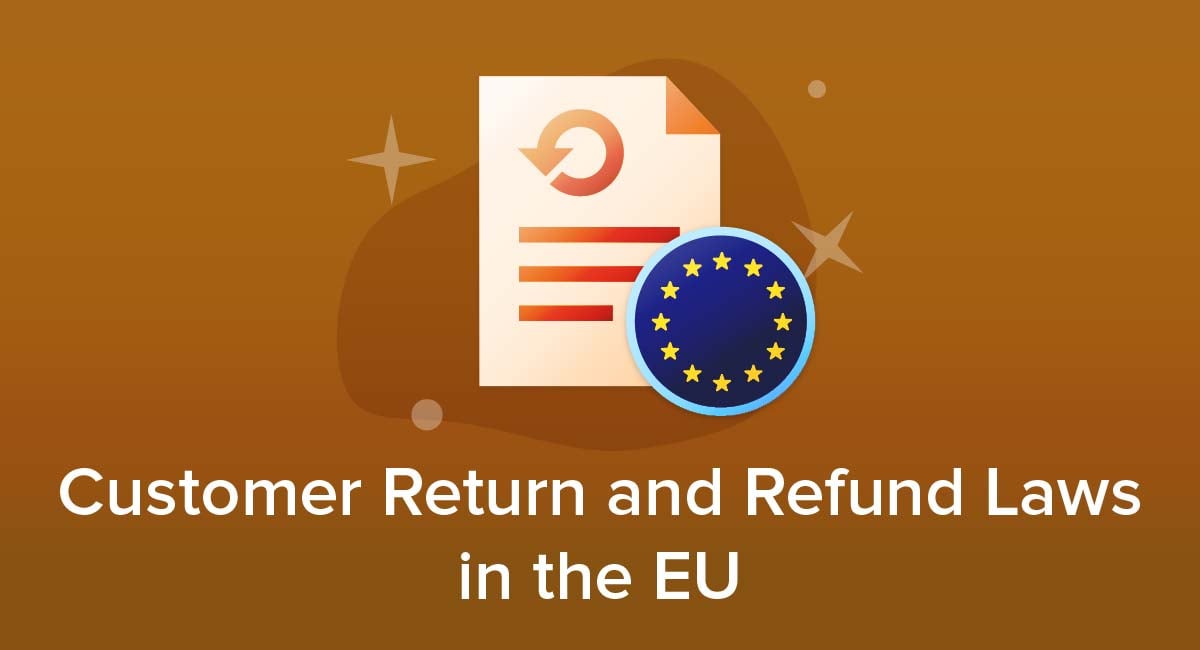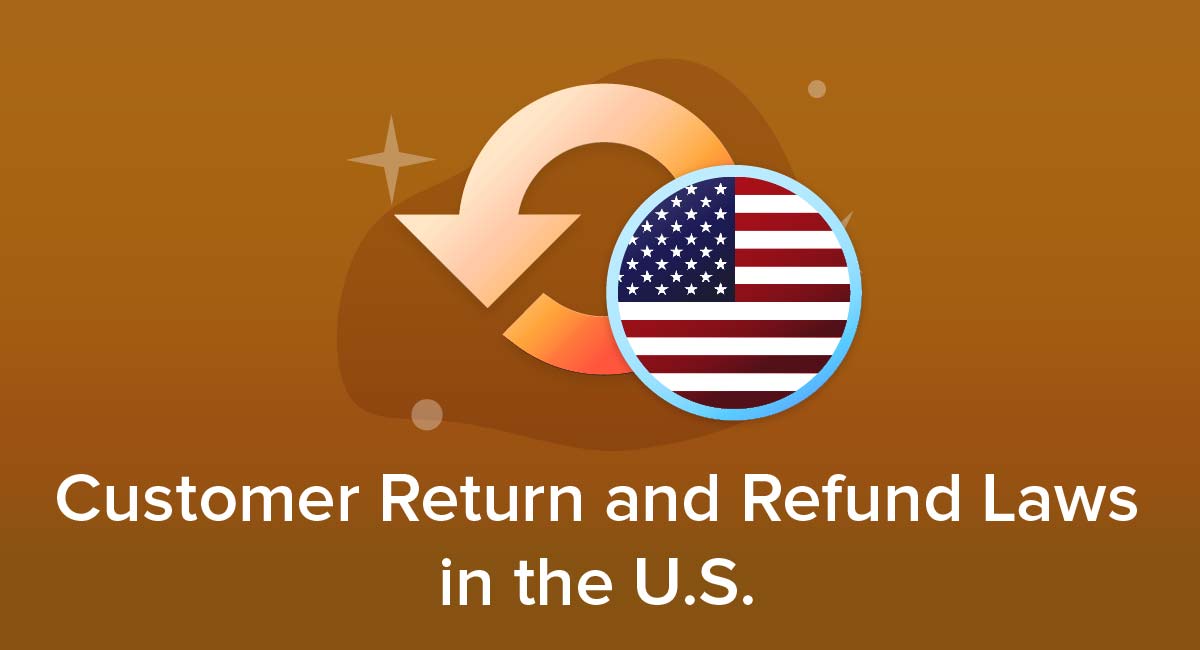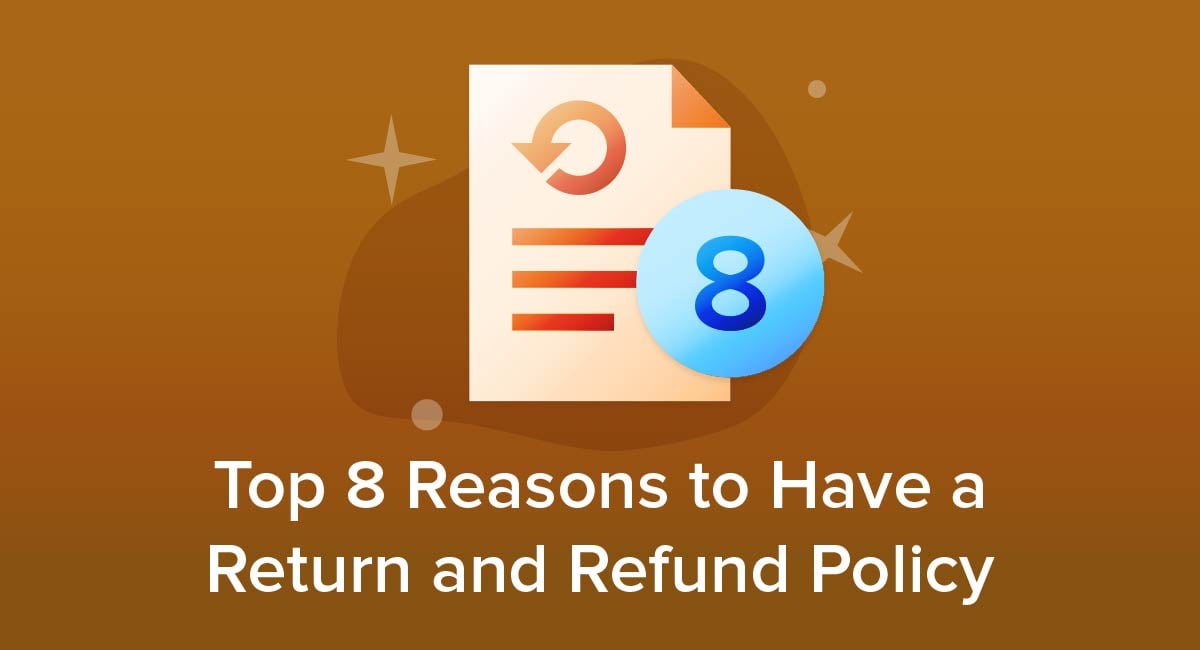
Even though customer returns are undoubtedly not your favorite part of running a shop or ecommerce store, they are part and parcel of retail sales. In spite of this, the U.S. does not have any federal laws requiring a Return and Refunds Policy. But that doesn't mean your store shouldn't have one.
There are many reasons to have and display a Return and Refund Policy to your customers.
Let's take a look at the top 8 reasons your business should have a Return and Refund Policy.
Use FreePrivacyPolicy.com to generate the necessary legal agreements for your website/app:
- Free Privacy Policy Generator
- Free Terms and Conditions Generator
- Free Cookies Policy Generator
- Free Disclaimer Generator
- Free EULA Generator
- Free Return & Refund Policy Generator
You check our Free Cookie Consent to start making your business legally compliant with the Cookies Directive in the EU.
1. Build Customer Trust

Customers expect to find a clear Return and Refund Policy that lays out your store's terms when they access your website or app. People generally don't like to shop at stores when they don't know if the return and refund process meets their expectations.
This policy creates a sense of security for customers and they are more likely to trust your business if your return procedures are clearly displayed.
If a customer fails to find your Return and Refund Policy they may start distrusting your store and decide to make their purchase elsewhere amid fears it will be too complicated to return an item if they need to.
In addition, if a customer has already made a purchase but is then unable to find a Return and Refund Policy, they may decide it's too hard to return the item and simply write off your store as one to avoid in the future.
To build trust and retain your customers you should ensure that your Return and Refund Policy is displayed prominently on your website. Customers will appreciate that you're upfront about your procedures.
Walmart displays its Return and Refund Policy prominently on its website in a few different places, including the website footer:
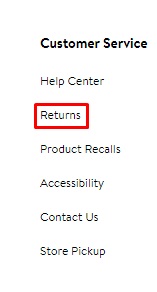
This meets customer expectations and helps to build trust with customers.
2. Increase Sales and Attract New Customers

You may not have thought that a Return and Refund Policy could add to your marketing strategy, however displaying this policy could actually increase your sales because a high percent of shoppers look for it.
A Narvar Consumer Survey found that 49% of customers actively check the retailer's Return Policy before buying anything. In addition, consumers who are informed about their rights to refunds and returns are more likely to make a purchase.
The Return and Refund Policy is seen by many people as a guarantee that the product will be good or else they will be able to get their money back. The fact that the seller is making it clear that the customer can get a refund shows that the seller must think their products are good quality.
In this way your policy is a helpful marketing tool that demonstrates the trust you place in your products and the trust that customers can place in your business.
Instead of viewing returns as a necessary evil, embrace them and use your Return and Refund Policy to attract new customers. Proudly display your clear returns process and emphasize any benefits, for example, a long returns period or the ease of the process to encourage people to buy.
KeraStraight's 'no quibble returns' policy is sure to attract customers with its straightforward approach, which is a great marketing strategy:
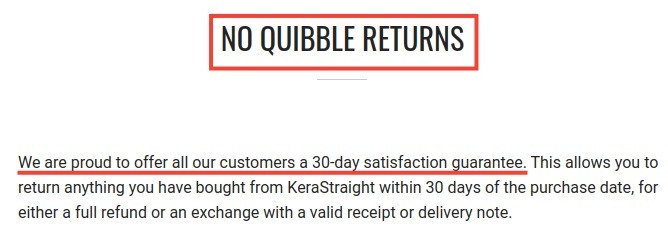
Once people have purchased an item, the Narvar Consumer Survey found that 'a great returns experience drives loyalty' to the extent that 95% of customers who are satisfied with a store's returns process would purchase again.
3. Manage Customer Expectations

It's best to manage your customer's expectations from the start as this will avoid future disagreements and misunderstandings.
Customers will be able to find out all the information they need before making a purchase, including what the time limit for returns and exchanges is and if there are any restocking fees.
For example, if you run a jewelry store your policy may say that items must be in original packaging and that earrings cannot be returned for hygiene reasons. This manages the customer's expectations and ensures there are no arguments about whether it is okay for the customer to return a pair of earrings they changed their mind about.
Jewelry retailer Pandora makes it clear that pierced earrings cannot be returned in the store's Return and Refund Policy, thereby managing customer expectations and avoiding disagreements:

Retailer Debenhams also advises what items cannot be returned, which establishes clear guidelines and manages the customer's expectations:
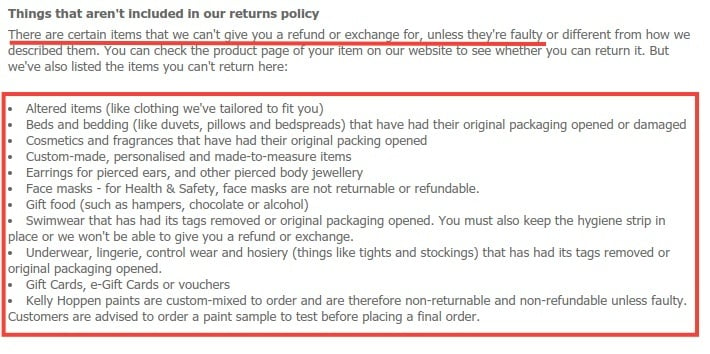
Be as detailed and specific as possible in your Return and Refunds Policy so your customers will be fully on the same page as you. This will create less issues for both of you whenever a customer has an issue with a return.
4. Save Yourself (and Your Customers) Some Time

If you don't display a Return and Refund Policy, customers will be forced to contact you with every question they have about returns, exchanges and refunds. This will cost your business valuable time by having to respond to the same questions over and over again.
It will also frustrate your customers who now have to wait for a response and an answer instead of simply being able to find what they were asking about. By the time you respond, they may have decided to take their business elsewhere.
To avoid this, display your Return and Refund Policy prominently to ensure your customer's questions are instantly able to be answered in one succinct place.
5. Comply with Other Laws

Even though there are no federal laws that require a Return and Refund Policy, there are some state laws which require businesses to have one in certain circumstances.
For example, some states require you to have a Privacy Policy if you do not issue refunds.
Florida state law requires a 'no refund' sign to be clearly displayed in stores that do not offer any refunds.
Any business that falls short of this requirement will be bound by state law to issue a full refund within 7 days of purchase to any customer returning an unused product with a valid receipt. The law basically assumes a Return and Refund Policy exists, unless a sign is clearly displayed to customers to warn them that no returns are available.
In addition to state laws, there are other countries' laws to consider if you sell outside of the United States.
For example, if you sell to UK customers you need to ensure you comply with the Consumer Protection from Unfair Trading Regulations. This law requires retailers to display a Return and Refund Policy and does not allow sellers to say that they do not offer refunds or that they only offer exchanges.
6. Professionalism

Having a Return and Refund Policy available to consumers, especially when displayed alongside a Privacy Policy and a Terms and Conditions Agreement, will demonstrate how responsible and professional your business is.
This will benefit businesses of all sizes, but may be a particular benefit to small businesses and businesses who are just starting out who are trying to build customer loyalty. People will be more likely to purchase from a business that appears professional and has all of the policies the customer expects to see available on their website or app.
7. Help Stop Fraudulent Returns

It will be harder to stop fraudulent returns if you allow returns but fail to have a proper Returns and Refunds Policy in place.
You could use your policy to warn customers that you track returns, which may deter fraudulent customers who return items frequently. The aim isn't to penalize honest customers or discourage them from requesting returns, but rather to dissuade customers who always intended to return the item.
For example, a fraudulent customer might buy an outfit for an event, wear that outfit to their event and then try to return the worn outfit to the store they purchased it from. It's a good idea to track these customers and advise that you look out for this sort of behavior.
KeraStraight include a couples of lines in the store's 'No Quibble Return Policy' which explains that the retailer keeps an eye on returns made within the 30-day return window to ensure customers are not abusing the system:
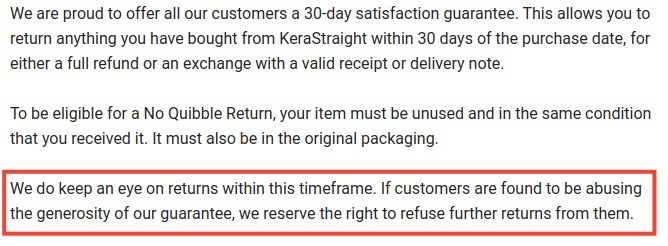
While you don't need to add text like this, it can help put potential return policy abusers on notice that your business won't be taken advantage of.
8. Preemptive Problem Solving

No matter how good your products and your customer service is, at some point a customer will want to return an item. It makes sense to have a clear set of guidelines to follow when this happens to avoid the stress of coming up with terms in a hurry when a situation arises.
If you don't have a Return and Refund Policy in place you may not have ironed out all of the details, including the process, the time limits and any exemptions. Plus, customers won't know their rights and responsibilities. It's far better to be prepared and have this policy in place.
Summary
Overall, a Return and Refund Policy will encourage consumers to buy from your store and to place trust in your brand. It can even be used as a marketing strategy to attract new customers and increase your sales.
This policy will make the duties and responsibilities of both parties clear so as to avoid any misunderstandings and disagreements. It will also enable customers to find answers to their return-related queries on your website, which will save you time answering questions via email or phone.
It's always great to be prepared and to make sure your store looks professional, so don't put off adding a Return and Refund Policy to your website.
